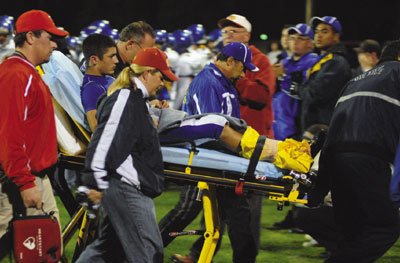When a football player is in perfect position to make a play,
the credit is often given to the athlete and/or coach for making
the correct read. But as many coaches will admit, their job can
only accomplish so much.
Editor’s Note:
This is the third and final article in a three-part series about head and neck injuries in football and how prepared local sports programs are in preventing and responding to such injuries.
When a football player is in perfect position to make a play, the credit is often given to the athlete and/or coach for making the correct read. But as many coaches will admit, their job can only accomplish so much. By putting the player in the best possible position to succeed and letting the athlete loose, a coach gives the team the best chance to win. Nothing more can be asked for.
The same goes for preventing injuries.
With the proper amount of training and instruction before and during a season, the likelihood of sustaining a catastrophic injury is greatly reduced. Beginning with spring and summer practices up through maintaining proper nutrition and treatment over the course of a season, players can give themselves a far greater opportunity to remain on the field, overcoming many of the aches and pains that occur during a grueling three-month schedule.
The following is a short list of some of the equipment and procedures in place to prevent and, if need be, respond to injuries at Gilroy High School’s football program:
– Gilroy High has three medical professionals who assist the school’s Certified Athletic Trainer Jennifer Spinetti: Dr. Maury Harwood, an orthopedic surgeon; Dr. Joe Kraut, an internist who specializes in general medicine, athsma and internal organ damage; and Ray Kusumoto, a physician’s assistant that has an extensive orthopedic and general medicine background with expertise in treating diabetes.
All three have been helping Spinetti at GHS for seven years as volunteers.
“Usually we have one of the three (doctors) here for each game,” Spinetti said. “This year we’ve had at least two.”
– Preseason physicals are given to each player by one of the three medical professionals, who ensure the athletes are physically fit to perform. All proceeds from the three doctor’s time are then donated back to the school, distributed evenly between the athletic department and the sports medicine program supervised by Spinetti.
– The doctors also give Spinetti access to their own materials to treat injuries.
– Helmets and shoulder pads are refurbished before the season every year by the GHS football program to ensure equipment functions properly.
– Commonly referred to as “hell week” or “double-days”, players are put through rigorous preseason training programs to strengthen their core, prevent overuse injuries and build neck muscles to prevent spinal cord damage from collisions.
– Before the season, all players are taught by coaches and shown an instructional video about how to tackle properly. The video is titled “Heads Up” and is approved by the National Athletic Trainers’ Association.
– Before the season, all players are given a talk about proper nutrition and hydration, which is reiterated over the course of the season by coaches and Spinetti.
– As a preventative measure based on position (Ex: Quarterback, running backs, receivers, etc.) or after a player has suffered a concussion, an individual is given a special mouthpiece known as the “Brain Pad”. Despite being bulkier than a normal mouthpiece – it secures the upper and lower jaw – this model is becoming more common amongst GHS football players across the board because it allows the impact from blows to the head to be lessened while providing a breathing hole. The model also comes with a $12,000 dental insurance policy.
– Saint Louise Regional Hospital recently donated two defibrillators to the GHS sports medicine program in case an athlete were to go into cardiac arrest.
– Gilroy Unified School District has a policy that an ambulance must be on site for all home football games, unless there is a local emergency that requires the ambulance.
– GHS Head Coach Rich Hammond has a policy that a player who suffers from any injury or illness will report directly to Spinetti so that the athlete can receive an expert’s assessment. The policy also eliminates any conflict of interest that could occur by taking coaches out of the equation in deciding if an athlete is fit enough to get back on the field.
Let us know if you feel comfortable about your high school football program’s ability to prevent or respond to injuries by contacting Green Phone at 842-9069 or e-mailing gr********@**********rs.com.















